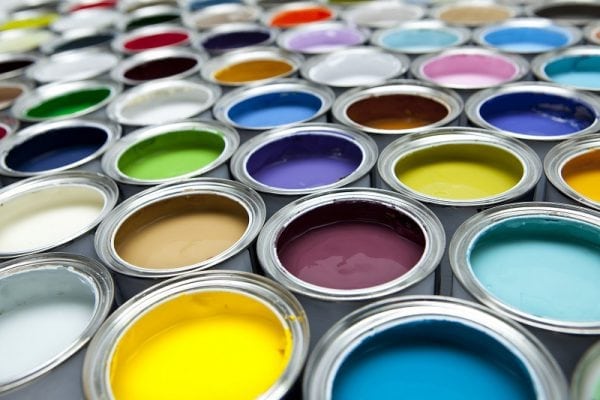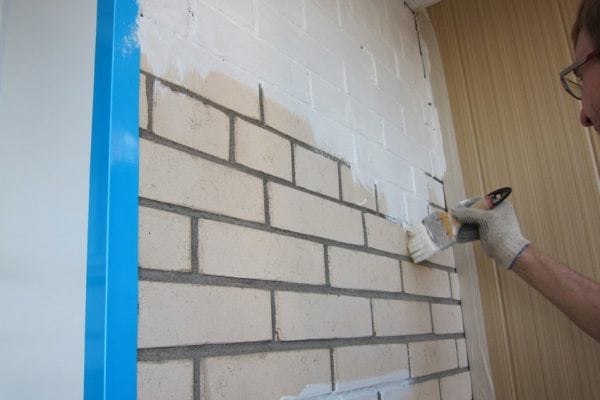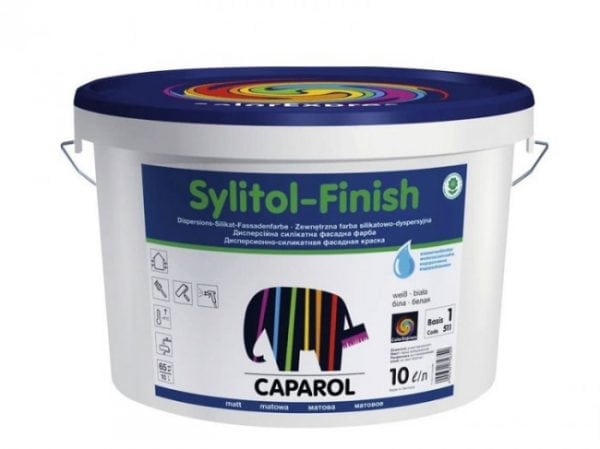One of the varieties of vapor-permeable one-component paints and varnishes is silicate paint. It belongs to the category of mineral paints, the basis of which is liquid glass.
Due to its special properties, this product is very convenient to use when performing a number of construction works. It is based on alkali-resistant components, and therefore there can not be too many coloring substances in it. Consequently, decorative possibilities are low.
to contents ↑Paintwork composition
In modern construction, high-quality silicate paints created on the basis of liquid glass with the addition of ethyl silicate are widely used, which, due to their properties, are ideal for facade work and painting walls indoors. In some cases, their composition contains special polymer substances - organosilicon resins, which give additional strength to the material.
To impart a particular shade, special pigments obtained from metals and having a powder form are added. Aluminum and zinc pigments also give pronounced anti-corrosion properties. The paint based on liquid glass and ethyl silicate acquires the necessary density by adding mica, talc, chalk and some other similar fillers.
The role of ethyl silicate in the composition of this type of paint is such that it contributes to the formation of a thin and viscous film, which is characterized by high mechanical strength and fire resistance. Most manufacturers use sodium ethyl silicate, known as GKZH-10. As a result, the paintwork material is able to maintain its original properties for a long time. In any case, the amount of ethyl silicate used should be exactly 10% of the total mass of liquid potassium glass that is in the base.
to contents ↑Scope of application
Having appeared relatively recently on the construction market, silicate paints quickly became popular and in demand. The scope of facade paints made on the basis of liquid potash glass and ethyl silicate is quite wide:
- Painting of any mineral wall surfaces: limestone, cement, cement-plaster and some others.
- Renovation of the facades of historical buildings, on the surface of which the paint crumbled or became dull and nondescript.
- Providing reliable protection against atmospheric phenomena for any building facades.
- High-quality updating of the external surfaces of walls that were previously treated with plasters.
This variety of coatings is also used for painting walls during internal work. It goes well with such types of coatings as:
- concrete;
- plasters (applied with a fresh layer or old and well puttied);
- brick - silicate and red;
- clay;
- gypsum.
to contents ↑Using such materials for treating walls and other surfaces, keep in mind that they are categorically incompatible with natural wood, polypropylene, polyvinyl chloride and other types of plastics, as well as with stone, which includes bard, resin and other organic components.
Varieties
To date, two main types of paintwork materials based on liquid glass with the addition of ethyl silicate are known - silicate-silicone and dispersion-silicate paints. There is a certain difference between them.
Dispersion-silicate paints in their composition contain approximately 8% of high-quality pure acrylic, which plays the role of a binder. Due to this feature, the diffusion properties of this agent are somewhat reduced. In addition, this type of paint coatings is one-component, that is, it does not require preparation immediately before use, while simple silicate paints consist of two separate components - liquid glass and powder.
Widely used for interior and exterior use and silicate-silicone paint. It is good in that it combines the best properties characteristic of dispersion and simple silicate paints. Since silicone resins do not form a film, the painted surface has the ability to “breathe”. In addition, such paints are vapor tight, and also provide any surface with reliable protection against rain and snow. Many well-known companies have well established production of this type of coating - Ceresit, Kreisel and others.
to contents ↑Terms of use
Silicate paints are very easily and conveniently applied to walls from both the inside and the outside. However, before painting them, the surface must first be prepared properly.
On the wall that you are going to process, there should not be particles of old paints or plasters - all this must be thoroughly cleaned.
In that case, if the surface of the facade is heterogeneous and, therefore, has a different degree of absorption, it must be treated with an aqueous primer.
When performing indoor or outdoor works using such paints, the air temperature should be at least + 5 ° C. In addition, precipitation and sunlight must be avoided on painted surfaces. Otherwise, the paint will acquire a spongy structure and become brittle.
Starting to paint, you should think about precautions in advance. Hand skin must be protected with rubber gloves. After using the container, keep it away from children.
to contents ↑Advantages and disadvantages
Paints based on liquid glass and ethyl silicate have many important advantages that distinguish them favorably from a number of other paint coatings.
- They are widely used for painting facades due to their increased resistance to ultraviolet radiation, as well as temperature extremes.
- They are chosen for painting building facades due to the fact that they are able to serve much longer and more reliably than those based on lime. They are resistant to even the most aggressive atmospheric phenomena - including smog and acid rain.
- Another important feature that encourages the use of liquid glass paint for exterior and interior use is its high biological resistance. This means that painting the walls with this product will prevent the appearance of fungi and other microorganisms, as well as protect against insects.
However, you should not lose sight of some of the disadvantages inherent in this type of paint and varnish products:
- The tool is toxic and unsafe, therefore, in the process of performing work, the use of special protective methods is required.
- Incompatibility with synthetic coatings with an organic basis.
- Absolute indelibility.
The use of paints based on liquid glass and ethyl silicate is a great opportunity to create a well-protected facade coating. In addition, they are indispensable in creating stained-glass windows and road marking. Getting started with them, study all the characteristic properties and rules of use.









